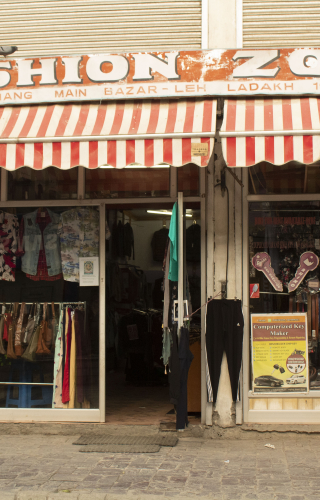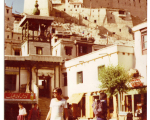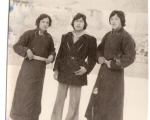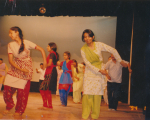When we speak about dress and identity in the context of clothing in Ladakh, it has been observed through early accounts of photographs, paintings and written documentation by early travellers that the people of Ladakh mainly wore simple long robes known as goncha (male dress) or sulma (female dress), made from local wool. These robes were secured around the waist by a belt made of wool or cotton. The robes are almost similar in style for both men and women except for the sul (gathered pleats) around the waistline of the woman’s dress. Children wore similar robes, though in some cases girls wore the male robe till they got married or reached puberty. There was also little distinction between winter and summer wear.
Trade brought a range of fabrics such as silk, silk-brocades, cotton, velvet, muslin and many more varieties. It is evident from the descriptions of early travellers as well as oral accounts of elderly Ladakhis that very few people could have afforded these imported fabrics, which came from China, Yarkhand, Punjab or the plains of India. Only royalty, aristocrats and ministers were seen to have adorned themselves with dresses made out of these fabrics. Some of this was prescribed by rules made by the king. It can, therefore, be implied that the style of textiles used by common people was limited to meet their basic necessity. Whereas the clothing style of aristocrats imply the extended social status that these people enjoyed. At the same time, the basic style of long robe, which is in style even today, continued.
Over time, the people of Ladakh became more receptive to clothing fashion and started to evolve and experiment with different fabrics, styles and statements. They started to enjoy and indulge themselves in dressing up with modern designs and innovating. This brought about a tremendous change in the dressing style, especially amongst the youth. Women started to adapt to more north Indian styles by wearing the salwar kameez, and with time complimented this with the sulma. The sulma also transited from being made only from wool to lighter imported fabrics from mainland India. Men wore assorted pants and shirts, whereas goncha was worn less often, its use confined to special occasions. In this process of change, dress in relation to identity in Ladakh took a stand and evolved a new global identity of its own.
In today’s Ladakh, the youth continue to take a lot of inspiration from metropolitan cities and global influence of the fashion industry. They do not want to lag behind when it comes to fashion. This evolving trend is flourishing with fast fashion which is now easily available in the ‘fancy’ shops of Leh Bazaar. Majority of the youth who are studying in Delhi, Chandigarh, Bangalore, Jammu and other parts of India are deriving their influence from fast fashion brands such as H&M, Zara and Forever21 amongst others. This has a direct impact on the millennials of Ladakh. The youth want to explore the many arenas of dressing, depending on different occasions and seasons. These clothing styles are a way of expressing themselves in this fast-moving society we now live in; they also experiment with hairstyles to compliment the look. For instance, if someone likes music, they would wear a Tee of their favourite band or singer. Likewise, if someone is supporting a gaming club or team, they would show their support for the team by wearing the club shirt. There are varieties of clothing style designed for specific activities in one’s daily life, and this is taking a lead in Ladakh as well. There is sportswear for exercising or mountain climbing, nightie for sleeping, comfortable pyjamas or sweatpants for a relaxing day. There are formals to wear for your work, or fancy dresses to glitter up a party life, or casual clothes for comfort. There are so many varieties of shoes as well, to match with any dressing style. In all, now there is an innumerable array of designs and prints and fabrics and styles to choose from, to keep up with trends as well as express interest or mood or identity. These varieties of contemporary styles and designs are easily available in the market compared to the time when everything were brought on caravans through trade.
As much as the youth enjoy wearing and find comfort in these contemporary clothes, they also love to wear their traditional dress and do not want to give up the cultural identity that is expressed through it. These dresses are symbolic of social identity in a culturally rich country like India and stand out to identify Ladakh on the global platform. Because of this enthusiasm amongst the youth, many fashion designers have emerged in Ladakh over the last decade. These young fashion entrepreneurs are coming up with new innovative ideas and trends to compliment the idea of global fashion and cultural identity amongst the people of Ladakh. The designers are creating their styles and outputting creative ideas to evolve and revive the traditional dress into a more functional/practical item in the day-to-day life of a common person. They are also experimenting and recreating traditional dress with a contemporary touch, keeping intact its essence and character. They strive to develop fashion with a focus on preserving the traditional uniqueness.
Fashion in Ladakh has come a long way from the days of wearing long woollen robes to new-age global designs. Apart from the youth, the older generation is also more receptive of these new designs and are slowly adapting to the new styles. While the youth find a sense of belonging in the traditional customs apart from experimenting with the contemporary lifestyle. Hence, we can see a trend of both global and local fashion going hand-in-hand in present day Ladakh.
This image gallery presents the fashion industry that has engulfed the Leh market today, and looks into how people are adapting to the new trends and styles. It also shares anecdotes from some designers who are trying to keep the idea of identity intact in their designs as they work amidst all things modern.
















